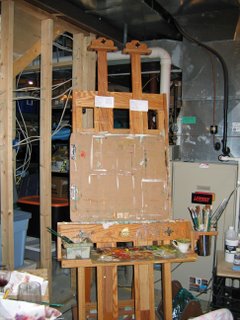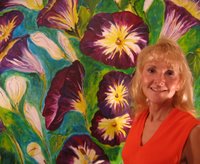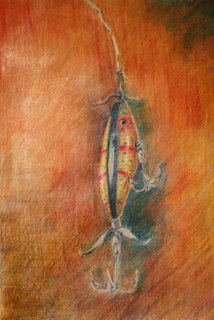Wow Is this why I'm up all night painting?
It seems people who're up late at night are more creative than those who get up early in the morning, according to a Discovery News report. It's thought to have something to do with "an adaptation to living outside of the norm". Read more about the link between creativity and night owls...
"Being in a situation which diverges from conventional habit — nocturnal types often experience this situation — may encourage the development of a non-conventional spirit and of the ability to find alternative and original solutions," lead author Marina Giampietro and colleague G.M. Cavallera wrote in a study to be published in the February 2007 issue of Personality and Individual Differences.
The researchers, who are both in the Department of Psychology at the Catholic University of the Sacred Heart in Milan, Italy, studied 120 men and women of varying ages.
A self-report questionnaire evaluated degrees of morning and evening dispositions. In fact, true morning and evening-oriented people are actually rare, since most of us fall somewhere in between.
Once the subjects were categorized into either morning, evening or intermediate types, they underwent three tests designed to measure creative thinking.
During the first activity, test subjects were asked to draw and title a picture based on an image shown by the researchers. For the second activity, called "incomplete shapes," test subjects added lines to create pictures out of straight and curved lines. They then were asked to title the pictures.
The final test was similar, only this time the individuals were presented with 30 pairs of vertical lines.
Scientists scored each completed activity on originality, elaboration, fluidity and flexibility factors. Evening types aced each test based on these criteria, while morning and intermediate type people struggled to get scores over 50.
The researchers also discovered that age didn’t curtail creativity.
"Our study supports the notion that creative characteristics persist in aged people," the scientists wrote.
Hans Van Dongen, associate research professor at the Sleep and Performance Research Center at Washington State University, helped to discover the biological explanation behind morning and evening types.
He and his colleagues found that a small group of brain cells, called suprachiasmatic nuclei, emit signals to the body that synchronize the time of day. This "biological clock" runs two hours ahead in morning types and two hours later in evening types.
Morning and evening-oriented people may follow other schedules, due to work, school and other demands, but their preferred schedule is more in sync with this internal clock, which may be partly determined by genetics.
Van Dongen told Discovery News that the finding about creativity and evening types is "certainly novel, and one I would not have expected on biological grounds."
He suggested that the observed differences in creativity might have to do with the fact that evening people also tend to be more extroverted than morning and intermediate types.
"One could reasonably envision a link between the personality trait of extraversion and the finding of creativity," Van Dongen said.
--------------------------------------------------------------------------------
Saturday, December 16, 2006
Tuesday, December 05, 2006
Two Sunflowers an Expressionist-Impressionist view
 I often call myself an Expressionist-Impressionist because of the bold colors and brush work that I use.
I often call myself an Expressionist-Impressionist because of the bold colors and brush work that I use.How Van Gogh Inspired the Expressionists
Dec. 11, 2006 issue - When Vincent van Gogh painted "Poppies in the Field" in 1889, neither the artist nor his subject had much relevance in the world. He was a troubled Dutch painter without much of a following, and his brash red flowers, while striking, announced nothing more profound than the coming of spring. Thirty years later, much had changed on both counts. The poppies came to symbolize the blood spilled by young soldiers on the battlefields of World War I, and the artist's fame had grown significantly since his death in 1890. That was due in part to the way his work affected German and Austrian expressionists in the early part of the 20th century. "His bombast is alien to me," Swiss-German artist Paul Klee wrote in his diary. "But he is without doubt a genius."
The extent of van Gogh's impact on the expressionists is the subject of a dazzling new show at the artist's eponymous museum in Amsterdam. "Vincent van Gogh and Expressionism" (through March 4) compiles almost 100 paintings and sketches by such artists as Klee, Wassily Kandinsky, Egon Schiele and Gustav Klimt. Viewed separately, these works are not obviously influenced by the Dutch master. But when they are hung beside his on subtly painted walls of yellow, blue and gray, van Gogh's colorful brushstrokes are readily apparent in the expressionists' flowing hues. "Van Gogh's influence on the expressionists was absolutely crucial," says exhibition curator Jill Lloyd. "Of course they drew their inspiration from other artists like Gauguin and Cézanne, but the spirit, the attitude to nature and the life force of van Gogh really spoke to them."
Expressionism blossomed in Germany and Austria when artists, influenced by the writings of Nietzsche, began to paint subjective feelings of scenes, leaning on personal experience and beliefs. This desire to present rather than represent led artists like Ernst Ludwig Kirchner and Max Pechstein naturally toward van Gogh, whose vivid depictions of such subjects as sunflowers evoked a certain spirituality. Kirchner and Erich Heckel—two of the men who formed the art group Die Brücke while studying architecture in Dresden—went "wild" after seeing an exhibition of 54 van Gogh paintings in 1905, according to one of their professors, Fritz Schumacher. If any member of the Brücke group had a tragic similarity to van Gogh, it was Kirchner, who suffered a breakdown while serving in the German Army. His "Schlemihl Tries to Seize the Shadow, in Vain" (1915) and a copy of van Gogh's "The Painter on the Road to Tarascon" (1888)—the original was destroyed by a fire during World War II—are strikingly similar when viewed next to each other. There is a turbulent feel to Kirchner's blue man, mocked by a black, foreboding shadow; van Gogh's painter also has a shadow following him—perhaps his conscience, or an unremitting sense of loneliness.
The Munich expressionists, known as Der Blaue Reiter, were especially awed by van Gogh's subtle and complex views of nature. The use of striking colors in August Macke's "Vegetable Fields" (1911) is not unlike van Gogh's "The Sower" (1888). Both artists create a sweeping motion in the perspective, as if the action is about to be sprung upon the viewer. Macke's fields have a purplish-blue tone akin to a Provençal lavender field; van Gogh used a similar blue to represent strong flowing water. The Russian émigré painter Alexej von Jawlensky was also a fan; after purchasing "The House of Père Pillon" in installments from van Gogh's sister-in-law Johanna, he wrote to thank her: "Van Gogh was to me both a mentor and example, to possess something by his hand was my deepest wish for many years."
Some of the expressionist works even seem to breathe new life into the van Goghs they hang beside. The bold colors in van Gogh's "Vineyards at Auvers" (1890) are enhanced by hanging next to two of Klimt's huge and dynamic landscapes, "Pond of Schloss Kammer on the Attersee" and "Orchard," with their strident greens and glistening touches of gold. The same holds true for van Gogh's "Sunflowers" (1889), set alongside Schiele's "Autumn Sun" (1914). Though the two depict the same type of flower, their impact is completely different. Painted on the eve of Europe's Great War, Schiele's dying flowers can be seen as an omen of the coming apocalypse. Van Gogh's still hearken back to a bright and simpler time.
© 2006 Newsweek, Inc.
URL: http://www.msnbc.msn.com/id/16009306/site/newsweek/?rf=nwnewsletter
Wednesday, November 29, 2006
The building of a Painting

Here is the still life set up.
I am currently working on an 11x14 oil on stretched canvas. I start with a drawing then draw it a second time with charcoal on the canvas.
 After I have done the drawing I then begin to fill in color. I work the entire painting some artist start at the top and work down. I get a better feel for the painting by working the whole canvas at one time.
After I have done the drawing I then begin to fill in color. I work the entire painting some artist start at the top and work down. I get a better feel for the painting by working the whole canvas at one time.This is one of several old juicers I have. I collect them weird I know. I have them sitting around my kitchen. I like this one because it's old depression glass and I like the green of it.
Well back to the painting more on this one tomorrow.
Sunday, November 12, 2006
Now Showing
I now have work on display at the Art Spot in Jackson Michiagn It will bw there until the first of January.
Thursday, November 02, 2006
Tree Town

I finished the second painting for the off the wall gallery in Ann Arbor Michigan.I haven't been blogging because of all the problems they have been having with the blog site. I like to add pictures and their system has been down for weeks. I spend hours posting my painting a day. I will add a picture of the tree banner as soon as I can.
Wednesday, October 25, 2006
The History of Garlic
 The word garlic comes from Old English garleac, meaning "spear leek". Egyptians worshipped garlic and placed clay models of garlic bulbs in their tombs. Folklore holds that garlic repels vampires, protects against the "Evil Eye" and wards off jealous nymphs, said to terrorize pregnant women and engaged maidens.
The word garlic comes from Old English garleac, meaning "spear leek". Egyptians worshipped garlic and placed clay models of garlic bulbs in their tombs. Folklore holds that garlic repels vampires, protects against the "Evil Eye" and wards off jealous nymphs, said to terrorize pregnant women and engaged maidens.
Saturday, October 21, 2006
Web Site Up
www.artbydelilah.com
It's up but not all the links are loaded. I've put a few pictures up to start. I have to have more taken of my work and added. I just want to have something that I could work with. So watch for my blog on the new and improved web site.
It's up but not all the links are loaded. I've put a few pictures up to start. I have to have more taken of my work and added. I just want to have something that I could work with. So watch for my blog on the new and improved web site.
Wednesday, October 18, 2006
Still Working On Web Site

I have been trying to divide my time between several paintings that I have commissions for and getting my web site done. Hopefully the web site will be up soon and painting can again be a focus.
I want to do some more paintings of Greece next. I spent several weeks on the islands of Greece this year. I have started some Paintings. That will be finished soon and I will then start working on some other paintings of that area.
Tuesday, October 17, 2006
Working on Web Site
I hope to have my web site up by the end of the week. www.artbydelilah.com Stay posted and I'll keep my fingers crossed that it will soon be up and working.
Monday, October 16, 2006
Sunday, October 15, 2006
The Off the Wall Project, Tree Town

The painting is coming. Obstacles are the size and texture of the banner. It is a plastic like material and very slipper. The paint just slides off. I have gesso on it to give it a little tooth for the paint to hold on to. I usually paint in oil but because this will hang outside for a period of time I am using acrylic because it is more durable to the elements.

Friday, October 13, 2006
Working on the Off The Wall Project


The Ann Arbor Michigan Art Center takes art beyond four walls into the street where 50 selected artists will create banners for the upcoming exhibit "Tree Town". For more information : http://www.annarborartcenter.orgn I am beginning my first banner, one of two that I will do. The difficulty in working on a banner are numerous. The surface is slipper, they are large and not stretched or on a backing. I have tapped the first one of the two that I am doing a streched canvas for support. I will be posting on this work as is it completed.
Thursday, October 12, 2006
Spooky
It's been a cold windy day. A birid hit the house so hard I thought the pictures would fall off the wall. Now speaking of pictures I need something to liven up this dreary day, so I got into the spirt of Halooween and did a painting of Dracula.
Check it out a http://paintingoftheday.blogspot.com
Check it out a http://paintingoftheday.blogspot.com
Wednesday, October 11, 2006
Monday, October 09, 2006
Right Side/ Left Side
Today I am working on my web site and I realize how much I prefer painting. Creating is such a personal thing. I will take a break soon and paint. I will post the drawing I am currently working on, a series of fishing lures the The Lure of Lures.
Sunday, October 08, 2006
Why I Paint

Welcome!
Why do I paint? I paint because nothing is more exciting to me then to watch a blank canvas fill with color,shape,movement, and texture. I want to share here how my curiosity drives the process of painting. I would like to share the complex process of how a painting develops.
From the start of capturing a sensation and moving through the conceptual stage to working with different images and finally a finish work. I will post pictures as they start and ideas that I am working on
Comments are welcome.
artbydelilah@artbydelilah@fatcow.com
Subscribe to:
Posts (Atom)





